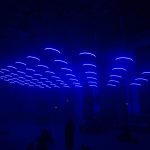“I not only use all of the brains I have, but all I can borrow.” — Woodrow Wilson, 28th president of the United States (1856-1924)
I, Swami Candela of the third millennium, know all, see all and tell all, except that which I do not know, see or tell. I know the words to “Louie, Louie,” and I know how many LEDs fit on the head of a pin. I hold all the answers to your lighting questions.
To illustrate, I ask you to pick up a pencil and paper at this very moment. Seriously, pick it up. Write down one question, one burning question you have about anything related to lighting, and I will address it at the end of this article. But be forewarned; if you do not write down a question, or if you choose to skip to the end, you will not find the answer. The answer will come only through your cooperation. During the last full moon, on the pages of this column there appeared an article by the regular author about the use of diffusion (“Focus on Design: The Illusion of Diffusion,” PLSN December 2006). The article elicited much comment from you, the illuminati. Many of you pointed out that softness of light has to do with the relationship between the size of the source and the subject. One such person was Joe Tawil, president of GAM.
I spoke to Joe on the phone after he wrote and invited me to do so. Joe didn’t invent diffusion material, but he did work to bring order and consistency to diffusion material. In the early days, he said, people used “found” material, whatever they could get their hands on, to diffuse light — vinyl, shower curtain, drafting velum… But he was “disgusted” with it because it was inconsistent, hard to get, and it caused little problems like melting over the audience from the hot lights.
Yet he knew that it was an important lighting tool for two reasons: it helped soften the light and improve the quality of shadows, and it was used to mechanically dim the lights. So Joe set out to develop a series of stepped diffusion material that was sequentially ordered. He knew it had to be made of polyester so it wouldn’t melt, and he wanted them to be in increments that correspond to f-stops, but he found that different sources produced different results.
He went on to explain how diffusion works, and the underlying principle that emerged was that the quality of the shadows is related to the size of the source compared to the subject. The throw distance, he said, was also an important determining factor. He wasn’t the only one who pointed these factors out.
Lighting designer Lee Rose of Design Partners wrote to say, “Your article brought into stark relief a common misunderstanding that I see in the video/film lighting field all the time. I always hear people talking about ‘how much softer the shadows are’ when they put some diffusion over what is basically a point source light. In truth, there is but one basic rule to diffusing light; the softness of the light is directly proportional to relationship between the size of the source relative to the object being illuminated.
“If you ‘diaper’ a Fresnel (hang diffusion over the ends of the barn-doors), you increase the source size from the 10-inch lens to about 20 inches across the doors. While this is a doubling of the source size, it will have very little effect on the apparent softness of the light if it is 20 or 30 feet from the subject.
“If you ever walk onto the set of a car commercial, you will most often see huge top sources. Products like the ‘Fisher Box’ come in various sizes including 17 feet by 57 feet. In relation to a car on a stage at 15 or 20 feet trim, you can see that the source is much larger than the subject.
“Even using a Chimera Lightbank on a Fresnel changes the 10-inch source with an area of about half of a square foot to a 36- inch-by-48-inch source with an area of 12 square feet. The relationship of the source to the subject is the final determination of how ‘soft’ the light is. That Chimera, four feet from a person, is soft, while 24 feet away it is not.
Thank you for reminding us that we tend to work from our perceptions and that in fact, they may not be correct. Actual hands-on experience, I have found, is the best teacher.”
Don Bachmeier, lighting applications specialist at Lowel-Light Manufacturing, Inc., had this to say: “The softness of a light is determined by the relative size of the source to the subject. A larger source will wrap around a subject, giving the shadow a softer gradation. The relative size of a Source Four 20 feet from the stage compared to a person is small no matter how many sheets of diffusion you pile on.
“Diffusion is often used to make the light a larger source. Stacking diffusion doesn’t make the light any softer unless each one makes the source progressively larger like softboxes.
“Close stacking diffusion can stand in for neutral density if you don’t mind the widened beam. I’m primarily a video guy, so having half a dozen grades of diffusion and a pocket full of clothes pins to make quick changes is the norm.”
Josh Alemany from Rosco also wrote to say, “Your article does a really nice job of breaking down diffusion effects and helping to shape a designer’s expectations when using these filters. Some years ago, a cinematographer named Tom Denove looked at a similar problem — how diffusion works in film/TV lighting. Here, the filter is placed away from the source at some point between the light source and the subject. His findings are documented in a Technote for Rosco called Diffusion Confusion, an abridged version of which can be found on our Web site.”
You may have wondered from time to time, who Swami Candela really is. The Swami is but a small medium of large proportions. He has 1000 eyes, 1000 ears and 1000 years of industry experience. Swami Candela is the embodiment of the industry, the sum total of the intellectual capital that is the production industry, the illuminati plenary. Swami Candela is you, you are I, and we are all together. Koo-koo-kachoo.
And now, Swami Candela will answer the question that you wrote down a few minutes ago. Fold the piece of paper in half, hold it close to your third eye, close your eyes, and concentrate on the question. Now go to the www.plsn.com/forums and you will find your answer. Or it could be at the Stage Directions forum (www.stage-directions.com). Or http://groups. yahoo.com/group/EntertainmentElectricity/. The answer to your question is in the air and in the minds of the people around. You have only to ask and the answer will appear.
Reach the Swami through the medium of email at rcadena@plsn.com.


